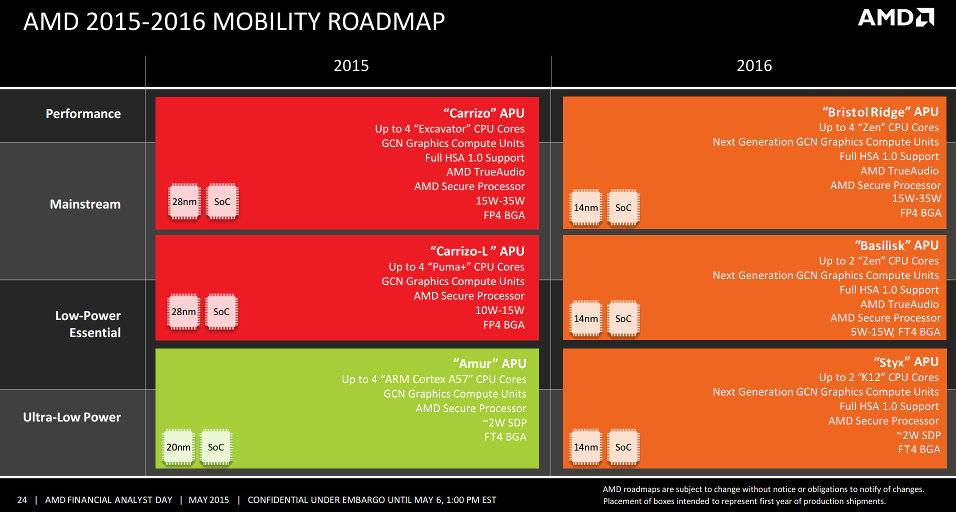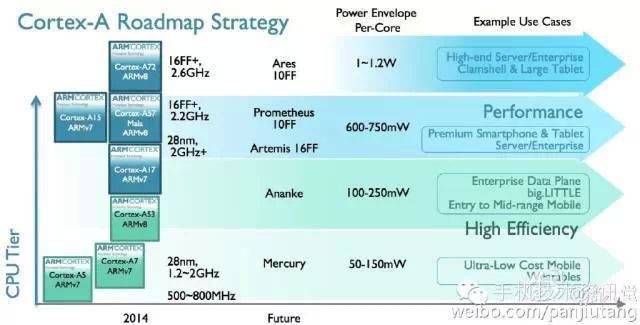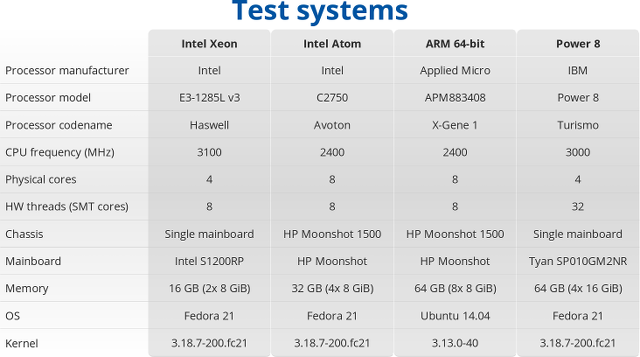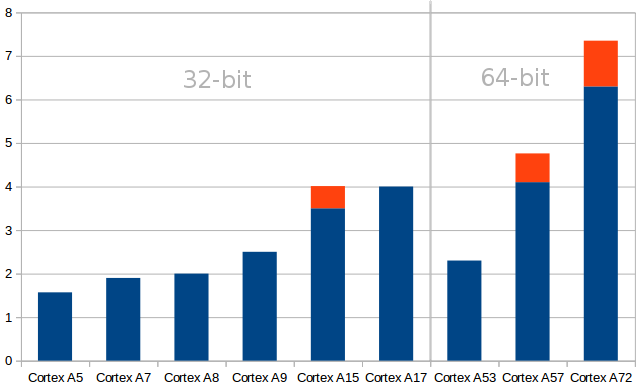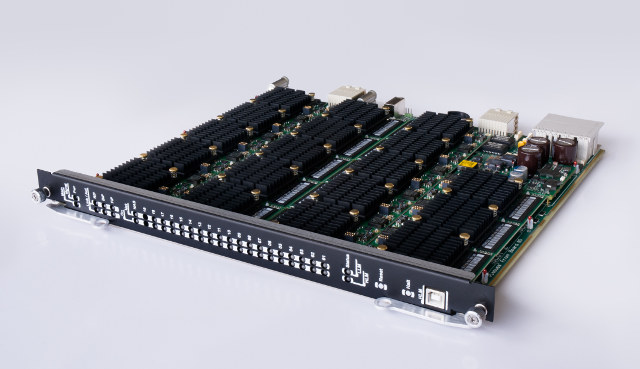There has been a few 96Boards announced so far, and a Banana Pi96 could soon be launched, as LeMarker has just joined the Linaro Community Board Group, but so far the board that generated the most buzz was Qualcomm Dragonboard 410c, but at the time pricing was not officially disclosed, although a $75 target price was posted in several blogs. And now it seems Qualcomm 64-bit ARM board indeed costs $75, as it is listed for that price on Arrow Electronics website with a few pieces in stock. Dragonboard 410c specifications have also been further detailed: SoC- Qualcomm Snapdragon 410 (APQ8016) quad-core ARM CortexA53 @ 1.2 GHz with Adreno 306 GPU @ 400MHz System Memory – 1GB LPDDR3 @ 533MHz, Single-channel 32-bit (4.2GBps) Storage – 8GB eMMC 4.51 + micro SD 3.0 (UHS-I) Video Output – HDMI up to 1080p Video Playback -1080p@30fps HD video playback and capture with H.264 […]
AMD to Launch ARM Cortex A57 “Amur” Mobile SoCs in 2015, ARM “K12” Mobile SoCs in 2016
AMD started using ARM Cortex A5 to add TrustZone security to their x86 processor, they followed with their ARM based Opteron A1100 processor for server last year, recently they announced Hierofalcon embedded processors powered by up to eight Cortex A57 processor, and starting this year and beyond, the company will launch “ultra-low power’ mobile SoCs using ARM cores, at least according to a leaked roadmap. Two ARM families are planned: “Amur” APU planned for 2015 with: Up to 4 ARM Cortex A57 cores GCN Graphics Compute Units AMD Secure Processor (Trustzone?) ~2W TDP 20nm process, FT4 BGA package “Styx” APU planned for 2016 with: Up to two “K12” CPU cores. These should be high performance custom-designed ARM cores. Next-gen GCN Graphics Compute Units Full HSA 1.0 support (Heterogeneous System Architecture) AMD Secure Processor ~2W TDP 14 nm process, FT4 BGA package With this kind of thermal dissipation, AMD Android and […]
ARM: “Microcontrollers Are Better Because There’s No GPL”
[Update: ARM has pulled down the video and issued a statement] ARM has uploaded a video today entitled “Microcontrollers for Makers” showing the benefits of using micro-controller boards instead of processor based development boards such as Raspberry Pi or ODROID-C1, and their four first points are right on target, but the last one, as mentioned by Olimex, is completely wrong, and already made several people upset. Let’s go through the first four points: Micro-controllers are more energy efficient, so if your project is requires years on a cell-coin battery, MCUs are the way to go. MCU are cheaper too, now you can even get an MCU board for $1. They are smaller. The chip shown on the golf ball is Kinetis KL03 If you need real-time I/O, processors can’t beat micro-controller, that why people decide to connect an Arduino board to their Raspberry Pi, or products like UDOO Neo are […]
ARM Roadmap Reveals Plans for 10nm FinFET Processors
A few slides have been leaked including ARM Cortex-A roadmap, allowing to have a peak at what the future will bring after the recently announced Cortex A72, and other existing cores. There’s nothing about performance, but this provides details about the next cores codenames and their manufacturing process. ARM cores are sorted into 4 categories: High-end servers and large tablets – Cortex A72 (16nm FF+) will be supplanted by Ares core optimized for 10 nm FinFET process Premium smartphones and tablets / servers – Cortex A15 and A57 cores will give way to Prometheus (10nm FF) and Artemis (16FF) cores Enterprise data plane / big.LITTLE entry to mid range Mobile – Ananke cores should take over Cortex A17 and A53 cores. Ultra-low cost mobile & wearables – Mercury cores will replace Cortex A5 and A7 cores. There aren’t any date on the slides, but the new cores might be announced […]
Linux 4.0 Release – Main Changes, ARM and MIPS Architectures
Linus Torvalds “Ima Sheep” released Linux Kernel 4.0 on Sunday: So I decided to release 4.0 as per the normal schedule, because there really weren’t any known issues, and while I’ll be traveling during the end of the upcoming week due to a college visit, I’m hoping that won’t affect the merge window very much. We’ll see. Linux 4.0 was a pretty small release both in linux-next and in final size, although obviously “small” is all relative. It’s still over 10k non-merge commits. But we’ve definitely had bigger releases (and judging by linux-next v4.1 is going to be one of the bigger ones). Which is all good. It definitely matches the “v4.0 is supposed to be a_stable_ release”, and very much not about new experimental features etc. I’m personally so much happier with time-based releases than the bad old days when we had feature-based releases. That said, there’s a few […]
HPC Performance & Power Usage Comparison – Intel Xeon E3 vs Intel Atom C2720 vs Applied Micro X-Gene 1 vs IBM Power 8
Last year, the CERN published a paper comparing Applied Micro X-Gene (64-bit ARM) vs Intel Xeon (64-bit x86) Performance and Power Usage, and they’ve now added IBM Power 8 and Intel Atom Avoton C2750 processor to the mix in a new presentation entitled “A look beyond x86: OpenPOWER & AArch64“. So four systems based on Intel Xeon E3-1285L, Intel Atom C2750, Applied Micro X-Gene 1, and IBM Power 8 were compared, all running Fedora 21, except the HP Moonshot 1500 ARM plarform running Ubuntu 14.04 and an older kernel. All four systems use gcc 4.9.2, and Racktivity intelligent PDUs were used for power measurement. I’ll just share some of their results, you can read the presentation, or go through the benchmark results to find out more. HEP-SPEC06 is a new High Energy Physics (HEP) benchmark for measuring CPU performance developed by the HEPiX Benchmarking Working Group, and here it’s not […]
Relative Performance of ARM Cortex-A 32-bit and 64-bit Cores
Many people assume newer processors will be faster, or that 64-bit processor will provide a performance boost compared to 32-bit processors, but the reality can be quite different, and I’ve decided to have a look at ARM Cortex-A cores using ARMv7 (32-bit) and ARMv8 (64-bit) architecture, and see what kind of integer performance you can expect from each at a given frequency. To do so, I’ve simply use DMIPS/Mhz (Dhrystone MIPS/Megahertz) values listed on Wikipedia. Drystone benchmark has no floating-point operating, so it’s a pure integer benchmark. I’m only looking at ARM core here, and once integrated in an SoC, other parameters like memory bandwidth, amount of cache, GPU, etc.. will greatly affect the overall system performance. The figure above are per MHz, and it does not mean for example that a Cortex A5 processor will be slower than a Cortex A7 processor, as can be seen by the comparison […]
Scaleway Provides Dedicated ARM Servers for 10 Euros per Month, 0.02 Euro per Hour
Earlier this year, Online Labs launched a beta hosting program using custom-designed C1 dedicated servers powered by Marvell Armada 370/XP quad core processor. The company has now launched a commercial service called Scaleway providing hosting service on these baremetal servers for 9.99 Euros per month, or 0.02 Euro per hour, as well as a “Infinite Storage” service with 1GB data for 0.02 Euros per month. Here are the details of the 10 Euros plan: Server based on Marvell Armada 370/XP quad core ARMv7 processor Memory – 2GB Memory Storage – 50GB SSD Disk 1x Reserved public IPv4 200Mbit/s – Unmetered bandwith Operating Systems – Ubuntu, Debian, Fedora, ArchLinux ARM. Docker supported. That’s not a VPS, but a dedicated server. For reference, I currently pay around $20 per month (Linode) for a server with an Intel Xeon E5-2680 dual core processor with 2 GB RAM and 50 GB SSD storage, and 3 […]



